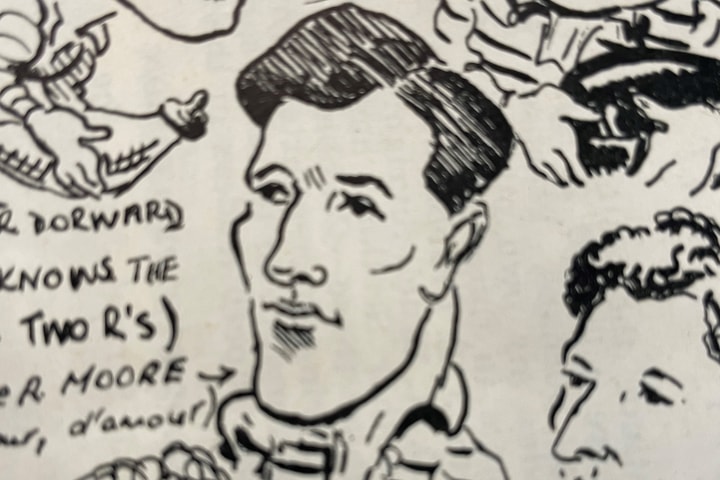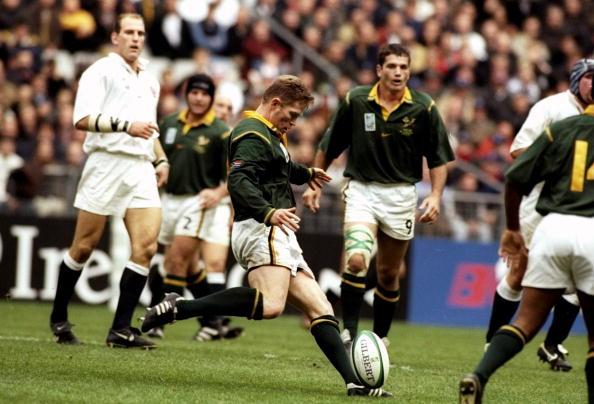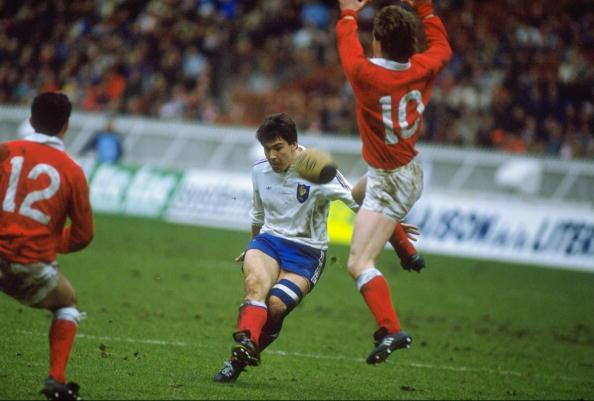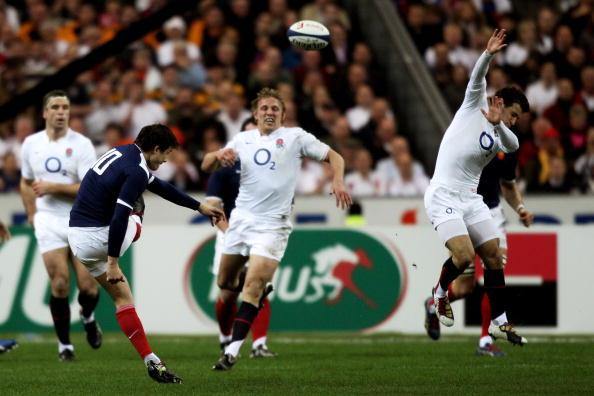
21 November 2025

Kicking a drop goal has often proved a decisive factor in the winning of matches at international level since the second match between England and Scotland at The Oval in 1872 when Harold Freeman for England and Charles Cathcart for Scotland each scored a drop goal.
Some prolific drop goal specialists in recent years come to mind - England's Rob Andrew and world record holder Jonny Wilkinson; Scotland's John Rutherford and Dan Parks; Ireland's Ronan O'Gara and the Welsh fly half maestros Barry John and Jonathan Davies; Phil Hawthorne of Australia and South Africa's Naas Botha and Jannie de Beer, architect of England's downfall in the 1999 World Cup with five sensational second-half drop goals in twenty five minutes.

Jannie De Beer during South Africa v England, 24/10/1999,
Stade de France.
(Photo Credit: Dave Rogers/Allsport)
Arguably only the All Blacks have shown a reluctance to use this unique scoring method. Such formidable kickers as Grant Fox, Andrew Mehrtens and Dan Carter only kicked 25 drop goals between them in a total of 228 international matches, whereas Jonny Wilkinson kicked 36 drop goals in a career of 97 matches which included six tests for the British and Irish Lions.
Between 1893 and 1948, a drop goal was worth four points and many an international was decided in favour of a drop goal if the other side could only manage to score an unconverted try worth three points. From the 1948-49 season, the value of the drop goal was reduced to three points but, although the number of drop goals each season has fluctuated, there does seem to be one country that has wholeheartedly embraced the practice.

Jonny Wilkinson during France v England, 23/02/2008, Stade
de France.
(Photo Credit: David Rogers/Getty Images)
No French player dropped more than one goal in his career from 1906 to the beginning of World War Two and then the floodgates opened. The first post-war French scrum half, Yves Bergougnan, dropped three goals, all worth four points, in his 17 internationals. While Jean Prat, the great French forward of the 1950s known as 'monsieur rugby', may have kicked only six drop goals in his 51-cap career, he was a back row forward and, as such, the All Black Zinzan Brooke with three drop goals in his 58 match career is the only forward to come remotely close to equalling Prat's versatility.
Moving on to post-war French fly halves, the rollcall of deadly marksmen is formidable. The tall and elegant Pierre Albaladejo from Dax in the French rugby heartland set a new record of 12 drop goals in his 30 internationals in a 10-year career which ended with victory in South Africa in 1964. He was soon followed by the diminutive fly half, Guy Camberabero from La Voulte, whose seven-year career overlapped with Albaladejo and ended with a drop goal to seal France's first Grand Slam in 1968. His tally of 11 drop goals was to be equalled twenty years later by his son Didier, but Guy scored his drops in 14 matches whereas his son needed 36 matches which included playing on the wing in the 1987 Rugby World Cup Final.
The doyen of French kickers in the 1970s was the decidedly unflashy Jean-Pierre Romeu from Montferrand. In 34 matches from 1972 to 1977, he scored a record 265 points with nine drop goals and he steered France to her second Grand Slam in 1977. His spiritual successor was the swarthy Jean-Patrick Lescarboura from Dax who notched up 15 drop goals, a French record that still stands, among a total of 200 points in his 28 internationals. He equalled Pierre Albaladejo's French record of three drop goals in a losing cause against the All Blacks in Christchurch in June 1986. The All Blacks were severely weakened by the suspension of those players who had toured South Africa with the New Zealand Cavaliers that summer and picked 11 new caps. Two of their debutants, fly half Frano Botica and full back Greg Cooper kicked three drop goals between them in their 18-9 victory, giving a still unique match total of six drop goals on that one afternoon.
The rollcall of prolific French drop kickers ran on through the 1990s into the 2000s. Guy Laporte from Graulhet was France's Grand Slam fly half in 1981 and weighed in with eight drop goals in 16 matches through the 1980s. Franck Mesnel was the young fly half from the Racing Club de France in the 1987 Grand Slam side and, although remembered more as a runner and distributor than a kicker, he still kicked two of his three drop goals that season. Thomas Castaignède of Toulouse and Christophe Lamaison from Brive, pivotal figures in the backlines of France's fifth and sixth Grand Slams in 1997 and 1998, scored 11 drop goals between them, and Lamaison scored two vital ones in quick succession in the second half to inspire France's recovery against the All Blacks in the World Cup semi-final in 1999.

Franck Mesnel during France v Wales, 18/02/1989, Parc des
Princes.
(Photo Credit: Russell Cheyne/Allsport)
In the 2000s, Frédéric Michalak and Francois Trinh-Duc continued the tradition with a further 16 drop goals during which France won a further three grand slams up to 2010. The tradition remains alive and, while Rob Andrew and Jonny Wilkinson have the largest totals of individual drop kickers in international rugby over the years, the French tally of more than 100 drop goals kicked by many different players since the 1960s shows that the drop goal has been an essential weapon in the armoury of their fly halves.

Francois Trinh-Duc during France v England, 20/03/2010, Stade de France. (Photo Credit: David Rogers/Getty Images)
Sources:
About the Author - A professional musician and arts administrator, Richard Steele has had a life-long love of sport. He has been on the committee of the World Rugby Museum at Twickenham since 2005.
Visit our website, book your visit and follow us on Facebook, Twitter and Instagram.